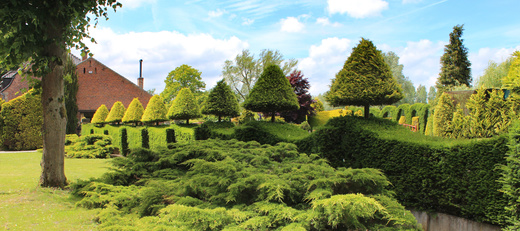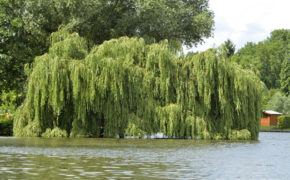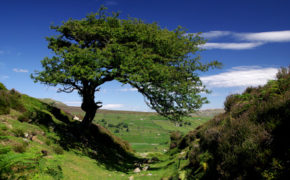
Get a quick no obligation quote It’s free and will only take a jiffy!
Yew Tree
Everything you need to know about the yew tree, from identification tips to typical characteristics; how to spot disease and the best way to maintain a yew tree.
The yew tree is a UK-native evergreen conifer, well known for living to a grand age of 400 to 600 years. It is believed and stated by the Woodland Trust that there are ten yew trees in Britain that predate the 10th century, so this is a tree with exceptional history and one we should be proud of as a nation.
There are various types of yew tree, including the Irish yew, English yew and numerous common yews including Icicle and Standishii which vary greatly in appearance, height and overall size from half a metre up to 20 metres. It is a popular tree for hedge forming as it provides year-round privacy screening and its red berry like fruits are very eye-catching.
General Facts
| Known as | Yew, English yew, common yew |
| Latin name | Taxus baccata |
| Location | Europe, West Asia |
| Foliage | Evergreen |
| Lifespan | 400-600 years |
Characteristics
| Height | Up to 20 metres depending on variety |
| Spread | 8 metres plus |
| Appearance | A medium sized bushy evergreen tree with red berry-like fruits that give the plant a ‘Christmas-like’ appearance. Bark is reddish-brown with hints of purple. Often shaped with topiary and a very popular hedging plant. |
| Leaves | Narrow, leathery leaves, very dark green in colour and arranged in two rows along the shoots. |
| Flowers | Flowers appear in March and April. Male flowers are insignificant yellowish-white round structures. Female flowers are scaly in texture and more bud-like, starting off green then browning to an acorn-like appearance. |
| Fruit | Edible fruit is smooth and oval Unlike most other conifers, yew tree fruits do not take on a cone-like appearance. Instead they are more berry-like; they are called arils and are red and fleshy and open at the tip. |
| Found in | Very popular in southern England as a hedging plant. Often found in churchyards, and in courtyard gardens as stylised topiary. |
Conditions
| Ideal soil | Any well-drained chalk, clay, sand or loam soil makes a good foundation for the yew tree which is hardy enough to withstand urban pollution and dry conditions. |
| Soil pH | Acid, alkaline, neutral |
| Aspect | North, south, east or west facing |
| Exposure | Full sun, full shade and partial shade |
Threats
| Pests | Tortrix moth, vine weevil, gall mites, scale insects |
| Diseases | Phytophthora root rot |
Yew Trees and Wildlife
Due to their denseness, yew trees offer exceptional protection for birds, as well as excellent nesting opportunities. Blackbirds, mistle thrush, song thrush and fieldfare enjoy the fruits of the yew tree, as do dormice and squirrels. The caterpillars of the satin beauty moth will often feast on the leaves.
Yew Tree Symbolism
Yew trees have a historical association with churchyards. In England there are at least 500 churchyards where yew trees grow and where these trees are said to be older than the building itself.
It is believed that yew trees were planted on the graves of plague victims in order to purify and protect them.
The yew tree is a symbol of immortality. The branches were carried on Palm Sunday and at funerals by tradition for many centuries. It is known as the ‘tree of resurrection’ and the ‘tree of eternity’ and is symbolic as the tree of life, which is very popular as jewellery pendants and symbolises protection, longevity, change, divinity and strength. In medieval times, yew was burned to assist in contacting passed over spirits.
The Importance of Yew Trees
Yew is a very popular, slow-growing, self-maintaining hedging and topiary plant, used extensively in courtyard and heritage gardens and is one of the most commonly used plants to create mazes.
Yew wood has been used for thousands of years and was historically the timber of choice to make tool handles and long bows. In 1911, a yew spear head was unearthed in Clacton-On-Sea which is reckoned to be in the region of 450,000 years old.
The close-grained denseness, rich warm sunny brown tone and narrow annual growth rings make yew strong and incredibly eye-catching, which is why it has become one of the most sought-after timbers by high-end furniture crafters.
The leaves of the yew tree produce anti-cancer compounds which are used in modern medicine. However, it is important to be aware that yew trees are in fact poisonous to humans and many mammals if ingested. Just a few leaves could induce serious illness in a child, and fatalities have been known. All parts of the tree are poisonous apart from the arils (berries), although even the black seeds inside them are toxic.
Caring for a Yew Tree
Yew trees do not call for much care and attention as they are slow growing, although they can be trimmed to keep them in shape. This is usually done twice a year, once in spring and then again in summer. Otherwise pruning really is mostly for show, although it is important to regularly check for signs of pests including the tortrix moth, the vine weevil, gall mites and scale insects. A periodic check for Phytophthora root rot is also important.
If you have a yew tree or any type of conifer tree on your land that needs expert care, why not talk to T.H. Tree Services? As fully qualified and highly experienced tree surgeons, we can offer comprehensive knowhow across all aspects of yew tree care, including a professional topiary service. For a free, no-obligation quotation, give us a call on 01268 642814 or get in touch here.
Amazing service from Mark and his team. We had a problem with Bamboo that had spread from a neighbours garden. Mark kept us informed with regular phone calls and images of how the work was progressing, as we were not present the house. 1st class job and a pleasure to do business with this company.
Thank you Colin and Gillian for your kind review. It was a pleasure to be able to clear the bamboo for you.








